
Disclaimer: Copyright infringement not intended.
Context
- The government’s reckless privatization and its plans to put India on sale now poses huge risks to the Indian economy and our people. PSUs are vehicle of social empowerment- Congress.
Whаt are РSUs?
- The term public sector undertaking or Enterprise refers to a Government Company. “Government Company” is defined under Section 2 (45) of the Companies Act, 2013 as any company in which not less than fifty-one per cent of the paid-up share capital is held by the Central Government, or by any State Government or Governments, or partly by the Central Government and partly by one or more State Governments, and includes a company which is a subsidiary company of such a Government company.
- Public Sector undertakings refer to commercial ventures of the Government where user fees are charged for services rendered. The tariff/fees may be market based or subsidised. They are usually fully owned and managed by the Government such as Railways, Posts, Defence Undertakings, Banks etc.
- Public sector enterprises on the other hand refer to those companies registered under the Companies Act, 1956,which are predominantly owned by Government and which are managed by a Government appointed Chairman and Managing Director. Government nominees represent the interests of the Government on the board of Public sector enterprises. Public sector companies usually compete with private sector enterprises in the domestic as well as international market.
Evolution of Public Sector enterprises
- At the time of independence in 1947, Indian industry was ill-developed and required considerable policy thrust. The Second Five year Plan (1956-61) and the Industrial Policy Resolution of 1956 provided the framework for public sector undertakings/enterprises in India, which were expected to play a substantial role in preventing the concentration of economic power, reducing regional disparities and ensuring that planned development serves the common good.
- A list of 17 industrial sectors was reserved for the public sector in Schedule A of the 1956 Resolution and no new units in the private sector in these categories would be permitted. Another list of industries was included in Schedule B where the Government actively encouraged public ownership.
- The Union Government and various sub-national governments made considerable investment on setting up and running public sector undertakings/enterprises.
- Initially, the public sector was confined to core and strategic industries such as irrigation projects (e.g. the Damodar Valley Corporation), Fertilizers and Chemicals (e.g. Fertilizers and Chemicals, Travancore Limited) Communication Infrastructure (e.g. Indian Telephone Industries), Heavy Industries (e.g. Bhilai Steel Plant, Hindustan Machine Tools, Bharat Heavy Electricals, Oil and Natural Gas Commission etc.).
- Subsequently, however, the Government nationalized several banks (starting with nationalization of the Imperial Bank of India which was renamed State Bank of India in 1955) and foreign companies (Jessop & Co, Braithwaite & Co, Burn & Co.).Later Public Sector companies started manufacturing consumer goods (e.g. Modern Foods, National Textile Corporation etc) and providing consultancy, contracting, and transportation services.
- The internal (profits) and extra-budgetary resources (borrowed funds) of public sector undertakings are factored into the preparation of the Annual Financial Statement (Budget) of the Government.
- However, poor productivity, poor project management, over-manning, lack of continuous technological upgradation, and inadequate attention to R&D and human resource development resulted in a large number of public enterprises showing a very low rate of return on the capital invested and the need for budgetary support for day to day running. Several of them accumulated huge losses and ran up huge debts which had to be written off /settled from time to time by the Government.
- Reviewing the role of the public sector, the Industrial Policy Resolution 1991 reduced the number of industrial undertakings exclusively reduced to the public sector to just six areas which included strategic industries like atomic energy, defence, coal, mineral oils etc. as well as railway transport.
- Efforts were made to divest non strategic public sector industries and to increase private participation in the equity of profitable public sector industries. At the same time a Board for Reconstruction of Public Sector Enterprises has been set up to suggest ways to turn around sick and loss making public sector enterprises.
Characteristics of Public Enterprises
Looking at the nature of the public enterprises, their basic characteristics can be summarised as follows:
- Government Ownership and Management : The public enterprises are owned and managed by the central or state government, or by the local authority. The government may either wholly own the public enterprises or the ownership may partly be with the government and partly with the private industrialists and the public. In any case the control, management and ownership remains primarily with the government. For example, National Thermal Power Corporation (NTPC) is an industrial organisation established by the Central Government and part of its share capital is provided by the public.
- Financed from Government Funds : The public enterprises get their capital from Government Funds and the government has to make provision for their capital in its budget.
- Public Welfare : Public enterprises are not guided by profit motive. Their major focus is on providing the service or commodity at reasonable prices. Take the case of Indian Oil Corporation or GAIL India Limited. They provide petroleum and gas at subsidised prices to the public.
- Public Utility Services : Public sector enterprises concentrate on providing public utility services like transport, electricity, telecommunication etc.
- Public Accountability : Public enterprises are governed by public policies formulated by the government and are accountable to the legislature.
- Excessive Formalities : The government rules and regulations force the public enterprises to observe excessive formalities in their operations. This makes the task of management very sensitive and cumbersome.
Difference between Private and Public Sector Enterprises
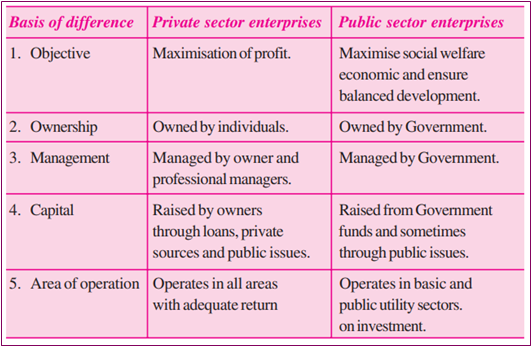
Forms of Organization of Public enterprises
There are three different forms of organisation used for the public sector enterprises in India. These are
(1) Departmental Undertaking;
(2) Statutory (or Public) Corporation, and
(3) Government Company
(1) Departmental Undertaking
Departmental Undertaking form of organisation is primarily used for provision of essential services such as railways, postal services, broadcasting etc. Such organisations function under the overall control of a ministry of the Government and are financed and controlled in the same way as any other government department. This form is considered suitable for activities where the government desires to have control over them in view of the public interest.
(2) Statutory (or Public) Corporation
Statutory Corporation (or public corporation) refers to a corporate body created by the Parliament or State Legislature by a special Act which defines its powers, functions and pattern of management. Statutory corporation is also known as public corporation. Its capital is wholly provided by the government. Examples of such organisations are Life Insurance Corporation of India, State Trading Corporation etc.
(3) Government Company
Government Company refers to the company in which 51 percent or more of the paid up capital is held by the government. It is registered under the Companies Act and is fully governed by the provisions of the Act. Most business units owned and managed by government fall in this category
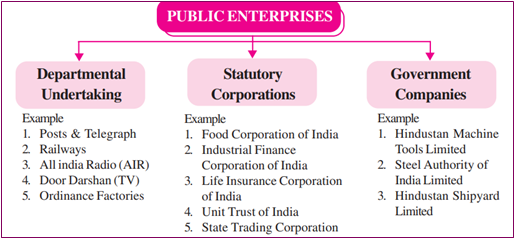
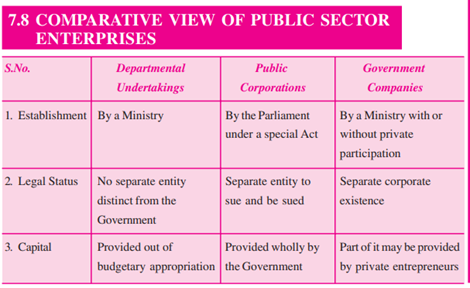
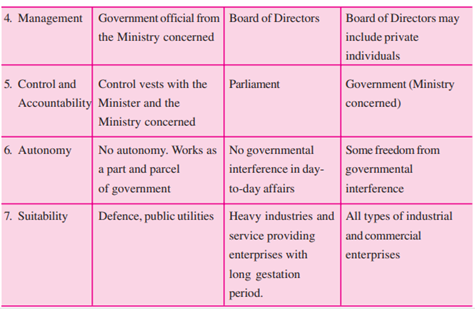
Importance of Public Enterprises
Public enterprises are playing an important role in the economic development of developing countries. They are involved in various sectors of economy. They play an active role in fulfilling the needs of people.
- Planned Development
Most developing countries have five years development plans for economic development. Public enterprises are given specific roles and targets in such plans. Public sector programs are also implemented by public enterprises. They are important for planned development of the country.
- Infrastructure Development
Infrastructure consists of transport, communication, power, irrigation, drinking water and buildings. They require huge investment and long period is required to complete them. Private sector is not interested in such investment. Public enterprises are important to build infrastructure in the country.
- Basic and heavy industries development
Iron and steel, electricity, cement, fertilizer, petroleum and telecommunication are examples of basic and heavy industries. They are essential for industrialization of the country. Private sector lacks resources and interest to invest in such industries. Public enterprises are important for the establishment of basic and heavy industries. Defense production is generally done by public enterprises.
- Public utilities concerns
Public utilities consist of services. They can be water supply, electricity, oil and gas, railways, airlines, public transport and telecommunications. They are essential for public welfare. Government has responsibility to provide such services at reasonable price. Public enterprises are important to provide public utility services at low cost.
- Balanced development
Government requires balanced development in all regions of the country. Private sector is not attracted to less developed regions because of low economic gain. Public enterprises are important for industrial development of backward regions.
- Employment creation
Government has responsibility to create employment opportunities in the country. Private sector is not interested to create employment at the cost of profit. Public enterprises are important to generate employment opportunities in the country. Their size is big and employee need is also big. They safeguard interests of employees.
- Government revenue
Public enterprises are important source of government revenue. They pay various types of taxes, such as customs duties, value added tax, excise duty, income tax and others. Such taxes are important in government revenue. Profit generated by public enterprises can be used to fund development programs.
- Economic growth
Public enterprises are the drivers of economic growth in the country. They develop infrastructure facilities and operate public utilities. They use modern technology for production purposes. All these aspects help in acceleration of economic growth in the country.
- Social welfare
Public enterprises provide essential goods and services at reasonable price. They also supply essential commodities such as fertilizer and food grains at subsidized price. They check price rise of essential goods by regular supply. This promotes social welfare in the country.
Maharatna, Navratna & Miniratna Companies in India
Public Sector undertakings (PSUs) or CPSEs are mainly divided in Maharatna, Navratna, Miniratna Category I & II on the basis of their financial performance, net worth, revenue, profit etc. The status of Maharatna, Navratna, or Miniratna to CPSEe is given by the Department of Public Enterprises to Public Sector Enterprises according to their financial performance and growth.
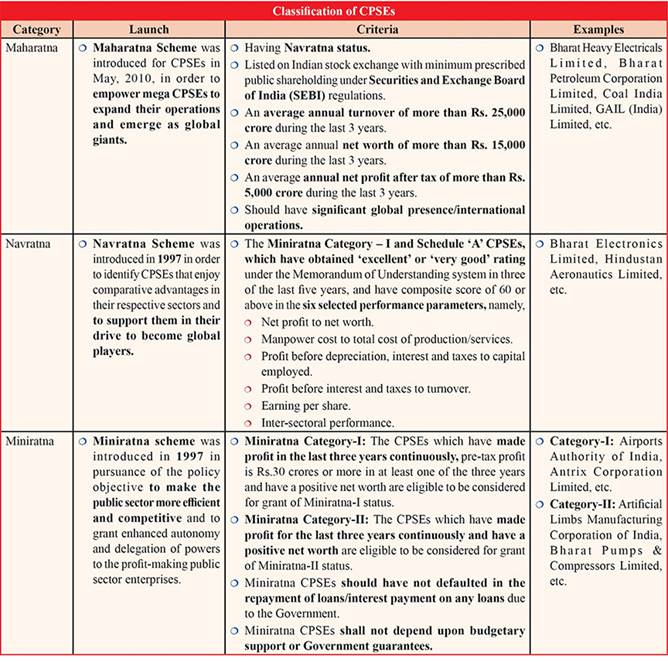
https://epaper.thehindu.com/Home/ShareArticle?OrgId=GJL9VOJJ2.1&imageview=0
http://www.arthapedia.in/index.php?title=Public_Sector_Undertakings/Enterprises
https://www.nios.ac.in/media/documents/SrSec319NEW/319_Bus_Studies_Eng/319_Bus_Studies_Eng_Lesson7.pdf
1.png)


















